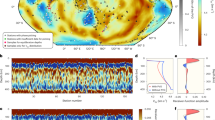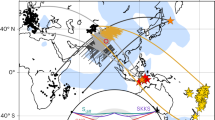Abstract
Plate tectonic theory hinges on the concept of a relatively rigid lithosphere moving over a weaker asthenosphere, yet the nature of the lithosphere–asthenosphere boundary remains poorly understood. The gradient in seismic velocity that occurs at this boundary is central to constraining the physical and chemical properties that create differences in mechanical strength between the two layers. For example, if the lithosphere is simply a thermal boundary layer that is more rigid owing to colder temperatures, mantle flow models1,2 indicate that the velocity gradient at its base would occur over tens of kilometres. In contrast, if the asthenosphere is weak owing to volatile enrichment3,4,5,6 or the presence of partial melt7, the lithosphere–asthenosphere boundary could occur over a much smaller depth range. Here we use converted seismic phases in eastern North America to image a very sharp seismic velocity gradient at the base of the lithosphere—a 3–11 per cent drop in shear-wave velocity over a depth range of 11 km or less at 90–110 km depth. Such a strong, sharp boundary cannot be reconciled with a purely thermal gradient, but could be explained by an asthenosphere that contains a few per cent partial melt7 or that is enriched in volatiles relative to the lithosphere3,4,5,6.
This is a preview of subscription content, access via your institution
Access options
Subscribe to this journal
Receive 51 print issues and online access
$199.00 per year
only $3.90 per issue
Buy this article
- Purchase on Springer Link
- Instant access to full article PDF
Prices may be subject to local taxes which are calculated during checkout


Similar content being viewed by others
References
King, S. D. & Ritsema, J. African hot spot volcanism: small scale convection in the upper mantle beneath cratons. Science 290, 1137–1140 (2000)
Zaranek, S. E., Parmentier, E. M. & Fischer, K. M. Effects of basal drag and ablation on the evolution of cratonic lithosphere. Eos 85(17), T41C–03 (2004)
Hirth, G. & Kohlstedt, D. L. Water in the oceanic upper mantle; implications for rheology, melt extraction and the evolution of the lithosphere. Earth Planet. Sci. Lett. 144, 93–108 (1996)
Gaherty, J. B., Kato, M. & Jordan, T. H. Seismological structure of the upper mantle; a regional comparison of seismic layering. Phys. Earth Planet. Inter. 110, 21–41 (1999)
Karato, S.-I. & Jung, H. Water, partial melting and the origin of the seismic low velocity and high attenuation zone in the upper mantle. Earth Planet. Sci. Lett. 157, 193–207 (1998)
Hirth, G., Evans, R. L. & Chave, A. D. Comparison of continental and oceanic mantle electrical conductivity: Is the Archean lithosphere dry? Geochem. Geophys. Geosyst. 1, 2000GC00048 (2000)
Anderson, D. L. Theory of the Earth, (Blackwell Scientific, Boston, Massachusetts, 1989)
Bostock, M. G. Mantle stratigraphy and evolution of the Slave province. J. Geophys. Res. 103, 21183–21200 (1998)
Dueker, K., Yuan, H. & Zurek, B. Thick-structured Proterozoic lithosphere of the Rocky Mountain region. GSA Today 11, 4–9 (2001)
Revenaugh, J. & Jordan, T. H. Mantle layering from ScS reverberations; 3, The upper mantle. J. Geophys. Res. 96, 19781–19810 (1991)
MONA LISA Working Group, MONA LISA—Deep seismic investigations of the lithosphere in the southeastern North Sea. Tectonophysics 269, 1–19 (1997)
Morozova, E. A., Morozov, I. B., Smithson, S. B. & Solodilov, L. N. Heterogeneity of the uppermost mantle beneath Russian Eurasia from the ultra-long-range profile QUARTZ. J. Geophys. Res. 104, 20329–20348 (1999)
Ryberg, T. et al. Two-dimensional velocity structure beneath northern Eurasia derived from the super long-range seismic profile Quartz. Bull. Seismol. Soc. Am. 86, 857–867 (1996)
Steer, D. N., Knapp, J. H. & Brown, D. L. Super-deep reflection profiling: exploring the continental mantle lid. Tectonophysics 286, 111–121 (1998)
Steer, D. N. et al. Deep structure of the continental lithosphere in an unextended orogen; an explosive-source seismic reflection profile in the Urals (Urals Seismic Experiment and Integrated Studies (URSEIS 1995)). Tectonics 17, 143–157 (1998)
Thybo, H. & Perchuc, E. The seismic 8° discontinuity and partial melting in continental mantle. Science 275, 1626–1629 (1997)
Shearer, P. M. Constraints on upper mantle discontinuities from observations of long-period reflected and converted phases. J. Geophys. Res. 96, 18147–18182 (1991)
Li, X. et al. Mapping the Hawaiian plume conduit with converted seismic waves. Nature 405, 938–941 (2000)
Collins, J. A. et al. Broadband seismology in the oceans; lessons from the ocean seismic network pilot experiment. Geophys. Res. Lett. 28, 49–52 (2001)
Li, X., Kind, R., Yuan, X., Wolbern, I. & Hanka, W. Rejuvenation of the lithosphere by the Hawaiian plume. Nature 427, 827–829 (2004)
Hatcher, R. D. Jr in The Appalachian-Ouachita Orogen in the United States (eds Hatcher, R. D. Jr, Thomas, W. A. & Viele, G. W.) 511–519 (Geological Society of America, Boulder, Colorado, 1989)
Heaman, L. M. & Kjarsgaard, B. A. Timing of eastern North American kimberlite magmatism; continental extension of the Great Meteor Hotspot track? Earth Planet. Sci. Lett. 178, 253–268 (2000)
Van der Lee, S. High-resolution estimates of lithospheric thickness from Missouri to Massachusetts, USA. Earth Planet. Sci. Lett. 203, 15–23 (2002)
Li, A., Forsyth, D. W. & Fischer, K. M. Shear velocity structure and azimuthal anisotropy beneath eastern North America from Rayleigh wave inversion. J. Geophys. Res. 108, doi:10.1029/2002JB02259 (2003)
Menke, W. & Levin, V. Anomalous seaward dip of the lithosphere-asthenosphere boundary beneath northeastern USA detected using differential-array measurements of Rayleigh waves. Geophys. J. Int. 149, 413–421 (2002)
Li, A., Fischer, K. M., van der Lee, S. & Wysession, M. E. Crust and upper mantle discontinuity structure in eastern North America. J. Geophys. Res. 107, doi:10.1029/2001JB000190 (2002)
Jackson, I., Fitz Gerald, J. D., Faul, U. H. & Tan, B. H. Grain size sensitive sesmic wave attenuation in polycrystalline olivine. J. Geophys. Res. 107, doi:10.1029/2001JB001225 (2002)
Lee, C.-T. A. Compositional variation of density and seismic velocities in natural peridotites at STP conditions: Implications for seismic imaging of compositional heterogeneities in the upper mantle. J. Geophys. Res. 108, doi:10.1029/2003JB002413 (2003)
Hammond, W. C. & Humphreys, E. D. Upper mantle seismic wave velocity; effects of realistic partial melt geometries. J. Geophys. Res. 105, 10975–10986 (2000)
Fouch, M. J., Fischer, K. M., Parmentier, E. M., Wysession, M. E. & Clarke, T. J. Shear wave splitting, continental keels, and patterns of mantle flow. J. Geophys. Res. 105, 6255–6275 (2000)
Acknowledgements
We thank L. Elkins-Tanton, D. W. Forsyth and G. Hirth for discussions. Data came from the IRIS Global Seismic Network, the US National Seismic Network, the Canadian National Seismic Network, and the Lamont Seismic Network. The National Science Foundation Geophysics Program provided support for this project.
Author information
Authors and Affiliations
Corresponding author
Ethics declarations
Competing interests
Reprints and permissions information is available at npg.nature.com/reprintsandpermissions. The authors declare no competing financial interests.
Supplementary information
Supplementary Figure S1
SV waveforms from station HRV are deconvolved and migrated in epicentral distance bins, illustrating one method we use to identify direct converted phases. (PDF 2746 kb)
Supplementary Figure S2
This demonstrates the trade-off in model parameters in our inversions. a) A range of models fits the phase from the base of the lithosphere at stations HRV and LMN. b) The range of acceptable models is limited by an independent constraint on the dominant period of the incident P-wave, which is determined by an auto-deconvolution test. (PDF 35 kb)
Supplementary Figure Legends
Full text to accompany the Supplementary Figures (DOC 21 kb)
Supplementary Methods
This describes the data included in our results, methods for identifying seismic discontinuities, ambiguous existence of the 61 km discontinuity, assumptions in our modelling, steps and methods of the inversions, auxiliary testing that ensures our assumptions do not affect the final results, error and parameter trade-offs, and the effects of temperature, hydration, grain size, and melt on seismic velocity. (DOC 81 kb)
Supplementary Table S1
This table summarises the parameters that were held fixed and those for which we inverted in each step of the inversions for HRV and LMN. (DOC 28 kb)
Supplementary Table S2
This table summarises the results of our inversions for velocities and thicknesses in the crust, lithosphere, and lithosphere-asthenosphere boundary at stations LMN and HRV. (DOC 32 kb)
Rights and permissions
About this article
Cite this article
Rychert, C., Fischer, K. & Rondenay, S. A sharp lithosphere–asthenosphere boundary imaged beneath eastern North America. Nature 436, 542–545 (2005). https://doi.org/10.1038/nature03904
Received:
Accepted:
Issue Date:
DOI: https://doi.org/10.1038/nature03904
This article is cited by
-
Lithosphere–asthenosphere boundary beneath the Sea of Japan from transdimensional inversion of S-receiver functions
Earth, Planets and Space (2021)
-
Melting of recycled ancient crust responsible for the Gutenberg discontinuity
Nature Communications (2020)
-
Indication from finite-frequency tomography beneath the North China Craton: The heterogeneity of craton destruction
Science China Earth Sciences (2018)
-
Shallow lithosphere-asthenosphere boundary beneath Cambay Rift Zone of India: Inferred presence of carbonated partial melt
Journal of the Geological Society of India (2016)
-
The slippery base of a tectonic plate
Nature (2015)
Comments
By submitting a comment you agree to abide by our Terms and Community Guidelines. If you find something abusive or that does not comply with our terms or guidelines please flag it as inappropriate.



